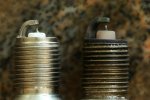I wanted to do a compression check and change my plugs to the Denso iridium type as they have the smallest diameter electrode (0.4mm). So the compression check values are as follows (21,000 miles on odometer):
Driver side front to rear:
186
190
186
185
Pass. side front to rear:
189
189
189
190
Here is the difference between the older NGK iridium and the new Denso plugs:

Jay
Driver side front to rear:
186
190
186
185
Pass. side front to rear:
189
189
189
190
Here is the difference between the older NGK iridium and the new Denso plugs:

Jay
Last edited:


